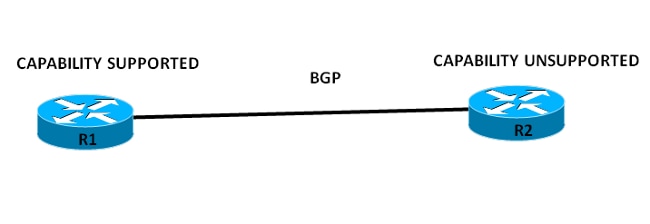Unsupported Capabilites Cause BGP Peer Malfunction
Available Languages
Introduction
This document describes a problem where the Border Gateway Protocol (BGP) peering does not function properly due to mismatched capabilities between the peers and provides a solution to the problem.
Problem
The BGP peer does not come up, and one neighbor reports this error:
BGP-3-NOTIFICATION?? received from neighbor x.x.x.x 2/7
(unsupported/disjoint capability) 2 bytes 4600
%BGP_SESSION-5-ADJCHANGE: neighbor x.x.x.x IPv4
Unicast topology base removed from session
??BGP Notification received
One of the BGP peers supports and tries to negotiate a BGP capability that is not supported by the other router.
Conditions
Consider this simple topology:

Router 1 supports a certain BGP capability that R2 does not support, and the BGP peer does not function. Router 1 displays this message:
BGP-3-NOTIFICATION received from neighbor x.x.x.x 2/7
(unsupported/disjoint capability) 2 bytes 4600
%BGP_SESSION-5-ADJCHANGE: neighbor x.x.x.x IPv4
Unicast topology base removed from session
BGP Notification received
If router 1 has other BGP peers that are established, enter the show ip bgp neighbor command in order to show the capabilities that are negotiated with other peers:
Router1#show ip bgp neighbor
<output shortened for brevity>
Neighbor capabilities:
Route refresh: advertised and received(new)
Four-octets ASN Capability: advertised and received
Address family IPv4 Unicast: advertised and received
Enhanced Refresh Capability: advertised
In this output, the capabilites marked as "advertised" are capabilities the router tries to negotiate with the neighbor. The capabilities that are "received" are supported and currently negotiated by the neighbor. Notice that this neighbor does not support, or does not negotiate the Enhanced Refresh Capability (possibly due to disabled negotiation), which is indicated in the output (no "received" for the Enhanced Refresh Capability).
Router 2 might display an error message that indicates a malformed BGP packet:
BGP-4-MSGDUMP unsupported or mal-formatted message received from x.x.x.x:
FFFF FFFF FFFF FFFF FFFF FFFF FFFF FFFF 002D 0104 95B0 00B4 7CC3 263B 1002 0E02
0041 0400 0095 B001 0400 0100 01
Additionally, this message can be decoded in order to discover if it is a BGP open message (contact the Cisco Technical Assistance Center). It also lists the capabilities for which negotiation was attempted. The capabilities this message attempted to negotiate are:
- Route Refresh Capability
- 4-byte AS Capability
- Multi-Protocol Capability
Solution
The BGP is established after negotiation of the specifed capability on R1 (the router that supports the capability) is disabled. This is done with hidden commands in the BGP process.
In order to turn off all capability negotiation, enter this command:
neighbor x.x.x.x dont-capability-negotiate
In order to disable negotiation for certain capabilities, enter these commands:
neighbor x.x.x.x dont-capability-negotiate four-byte-as
neighbor x.x.x.x dont-capability-negotiate enhanced-refresh
Revision History
| Revision | Publish Date | Comments |
|---|---|---|
1.0 |
29-Jul-2013 |
Initial Release |
 Feedback
Feedback